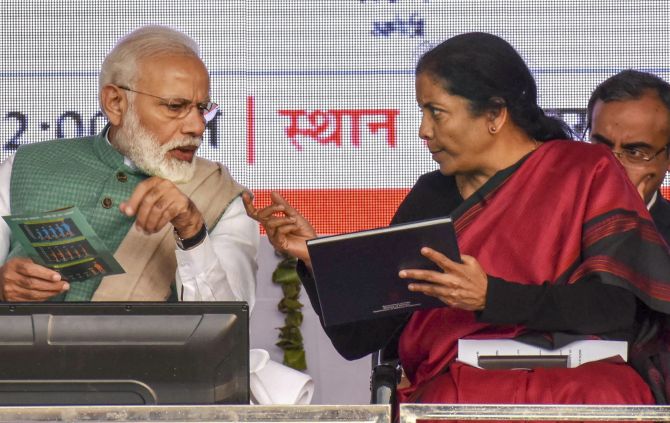KOLKATA: On Wednesday, Finance Minister, Nirmala Sitharaman, announced a bevy of financial measures to provide relief to the cash-strapped Indian non banking sector. A day after Prime Minister Narendra Modi announced the Atmanirbhar Bharat Abhiyan package worth ₹20 Lakh Crore to boost the economy of lockdown-bound India, FM Sitharaman specified that non-banking financial companies (NBFCs), housing finance companies (HFCs) and microfinance institutions (MFIs) will be supported through a ₹30,000 Crore liquidity scheme and a partial credit guarantee scheme worth ₹45,000 Crore.
“Under this (liquidity) scheme, the investment will be made in both primary and secondary market transactions in investment-grade debt paper of NBFCs/HFCs/MFIs,” FM Sitharaman stated, at a press briefing in the nation’s capital. RBI and government announced this measure, worth ₹30,000 Crore, to boost liquidity and securities, to be “fully guaranteed” by the centre. “This will provide liquidity support for NBFCs/HFC/MFIs and mutual funds and create confidence in the market,” she added. While announcing these steps, she assured that more such “tranches” are about to come in the next few days.
Finance Minister Sitharaman also said, “the government will provide 20% first loss sovereign guarantee to public sector banks. AA paper and below including unrated paper eligible for investment. This will result in total liquidity infusion worth ₹45,000 Crore to the system.”
The Partial Credit Guarantee (PCG) scheme, which was already in place before lockdown, allowed public sector banks to purchase high-rated pooled assets from financially sound NBFCs and HFCs.
Now, the finance ministry has extended this scheme to cover PSBs/CPs with ratings of AA and below, including unrated papers. Banks are yet to receive the specific ins and outs of these schemes from the centre. But, from what we know, the intention behind this “PCG Scheme 2.0” will be to provide liquidity support to institutions with low credit rating as well. This will enable them to continue lending to MSMEs which which cause low disruptions in the economic cycle.
That being said, these schemes will be over and above the ₹50,000 Crore funding, available under the RBI’s targeted long term repo operations (TLTRO 2.0). This facility was made available after MFs faced redemption pressure following the shutdown of 6 significant credit lines by Franklin Templeton.
Under the TLTRO 2.0 window, the banking sector can access cheap three-year funding from the RBI to invest in investment-grade papers of firms from the non-banking sector. At least 50% of these funds were meant for small and medium scale NBFCs and MFIs. Hence, some of these investment-grade debt papers include securities with low credit ratings. But, fortunately, even those have not been considered a waste.
PM Modi, in his latest national address, said that the comprehensive stimulus, provided for the struggling Indian economy, would amount to 10% of India’s GDP. He had also pointed out that the figure included measures that have been announced by the Reserve Bank of India (RBI) and the government in the past few weeks. “These measures are to spur growth and make India a self-reliant economy,” Sitharaman affirmed, in the press conference. However, she clarified that self-reliance does not mean that India is looking to be “isolationist”.
The government has been announcing a slew of measures for the various sectors of the Indian economy.
One of them was to broaden the upward definition of an MSME without changing any integral laws. The government also announced a fund with a corpus of ₹10,000 Crore to help the growth of MSMEs. Even those declared NPAs were included in a government measure worth ₹20,000 Crore, in subordinate debt to these MSMEs through a ₹4,000-Crore contribution to the credit guarantee trust for micro and small enterprises.
In another measure, Power Finance Corporation (PFC) and Rural Electrification Corporation (REC) were directed to provide relief worth ₹90,000 Crore to electricity distribution companies.
The government will also be asking states to extend the registration and completion dates of real estate projects suo moto by six months and advise them to treat COVID-19 as a ‘force majeure’ under the Real Estate Regulatory Authority Act.
On the other side, the government also announced that it will payout ₹20,000 Crore worth employee provident fund (EPF) contribution of both the employer and employees from eligible businesses for another 3 months until August.
Additionally, it also reduced the statutory contribution that a private sector employer and employee needs to make to EPF. This will provide a liquidity of ₹6,750 Crore to private sector firms and their employees, FM Nirmala Sitharaman said.
FM Sitharaman also announced tax concessions and liquidity support for several other market sectors as part of the government’s economic relief package.

